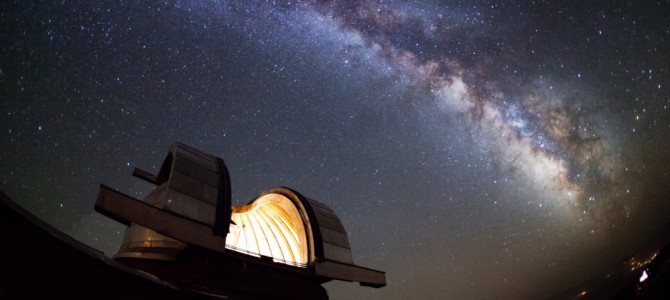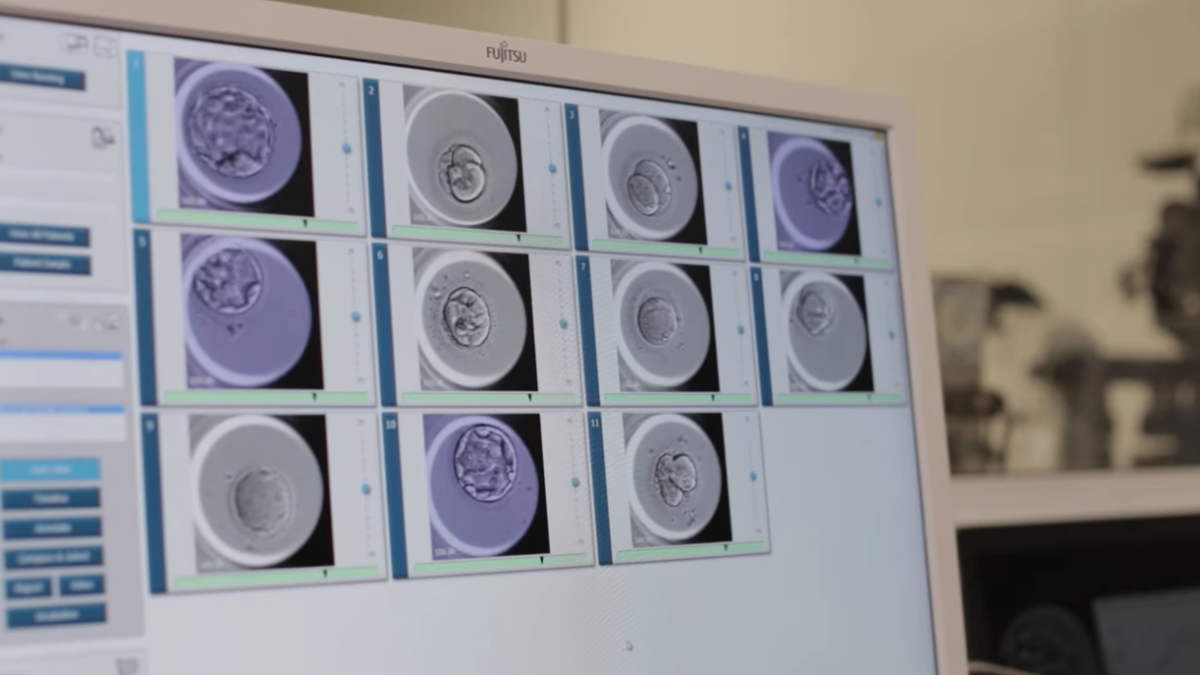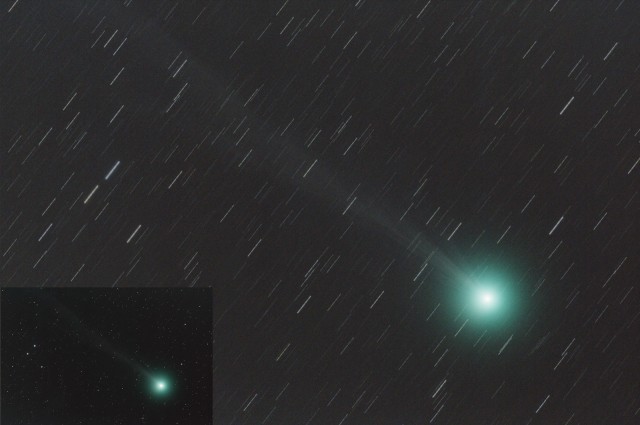
By now, you’ve probably seen the incredible images of amateur astronomer Terry Lovejoy’s latest find. For a guy armed with just an eight-inch telescope, he’s bagged an impressive five comets in the last seven years, three of which have been showstoppers at the eyepiece. His latest has brightened far beyond initial expectations, currently blazing at magnitude plus four in the faint constellation Eridanus. But you aren’t Lovejoy, or yours truly. Why is it green? How the devil can John Q Anybody see this wondrous fuzzball?
A Sun-Burned Visitor
Comet C/2014 Q2 Lovejoy takes on a striking appearance that at first seems out of the norm. When you think of a comet, you may think of a fiery white streak. That’s the popular image, and a pretty good one: when a new comet that brightens enough to dazzle is announced, it is often that comet’s first trek towards the sun. As a result, the dust and ice on and inside the comet’s nucleus vaporizes and streaks off as it heats up, and this dusty layer reflects the sun’s light, giving the comet its signature white look. Not all comets are the same, of course, and even those “discovered” have often been around the block a few times. In the case of Comet Lovejoy, very little dust is being produced, so the natural color of its head can be revealed. Diatomic carbon, not cyanogen, is the responsible party here, fluorescing in the UV sunlight and giving it that distinctive green glow.
What You Will See
When hunting down a comet for the first time, it is best to know what to expect. It isn’t going to take on the dazzling appearance captured by long-exposure photography, because CCD chips are far more sensitive than the human eye. This image, captured using an iPhone, approximates my view of the fuzzy green coma (the fuzzy haze enveloping the comet’s nucleus) from light-polluted Upland before its peak brightness:
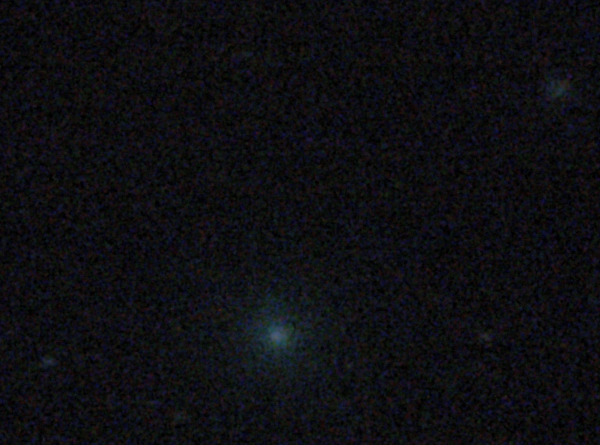
What you will see depends on four factors: weather, the moon, light pollution, and optics used; but you will certainly see it nearly anywhere if you have the right conditions: from the Battery in Manhattan or the Mall in DC, the fuzzy green coma will still appear on a clear night, through binoculars, and before the moon rises.
First, the weather. Cloudy skies will obviously hinder your hunt, but transparency is just as important, so check out SkippySky when you plan to look. Second, the moon. On January 7, you will need to limit your observations locally to just a few hours between twilight and moonrise, but as the moon wanes and rises about an hour later each night, your window opens. You will enjoy a moonless view if you observe around 9 p.m., when Orion is dominating the southern sky, from about January 10 onward. Third, light pollution affects the view, like it does with nearly all astronomical observations. Check out DarkSiteFinder, or with your local astronomy club, to find a reasonable spot. Lastly, the optics you use will affect what you see dramatically. Naked-eye observing is limited to just a fuzzy green spot, and will only be possible from darker skies. Binoculars will be your best friend, allowing you to sweep across the sky in your hunt with ease. If you have a telescope, or know someone who does, you may pull out even finer details, such as the faint tail.
A typical observation while the moon was just starting to spoil things comes from Irish artist and amateur astronomer Deirdre Kelleghan, who sat down on a cloudy evening with her binoculars and sketched this:
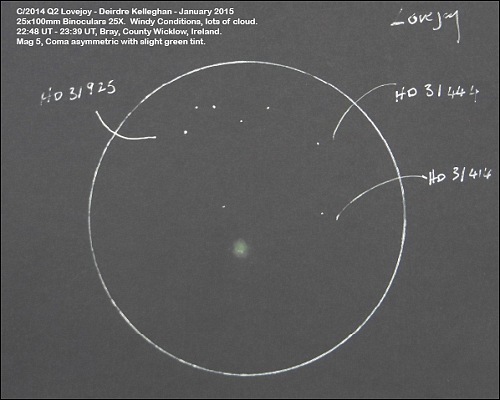
From her report:
Conditions were far from ideal , it was very windy and cloudy with too much moonlight. In between the cloud gaps I caught a glimpse of the comet in my 10X50 ‘s so I decided to set up my 25X100 ‘s binoculars in hope of a sketch. In Ireland , it is always a possibility that this could be my only opportunity to sketch this comet for days or weeks. Engulfed in Virginia creeper twigs I waited for a break in the relentless fast moving cumulus. The coma was large, the nucleus looked kinda oblong, not a pinpoint, not circular. There was no tail visible to me but the coma was asymmetric in shape, with a tint of green,diffuse at the edges. Nice star field on the edge of Lepus.
With the moon fading, the comet brightening, and local conditions almost certainly better for you than Deirdre’s in Ireland, you have a good shot of enjoying an even brighter sight.
Have a rough idea of what to expect? Well, you’re ready, then.
Where to Look
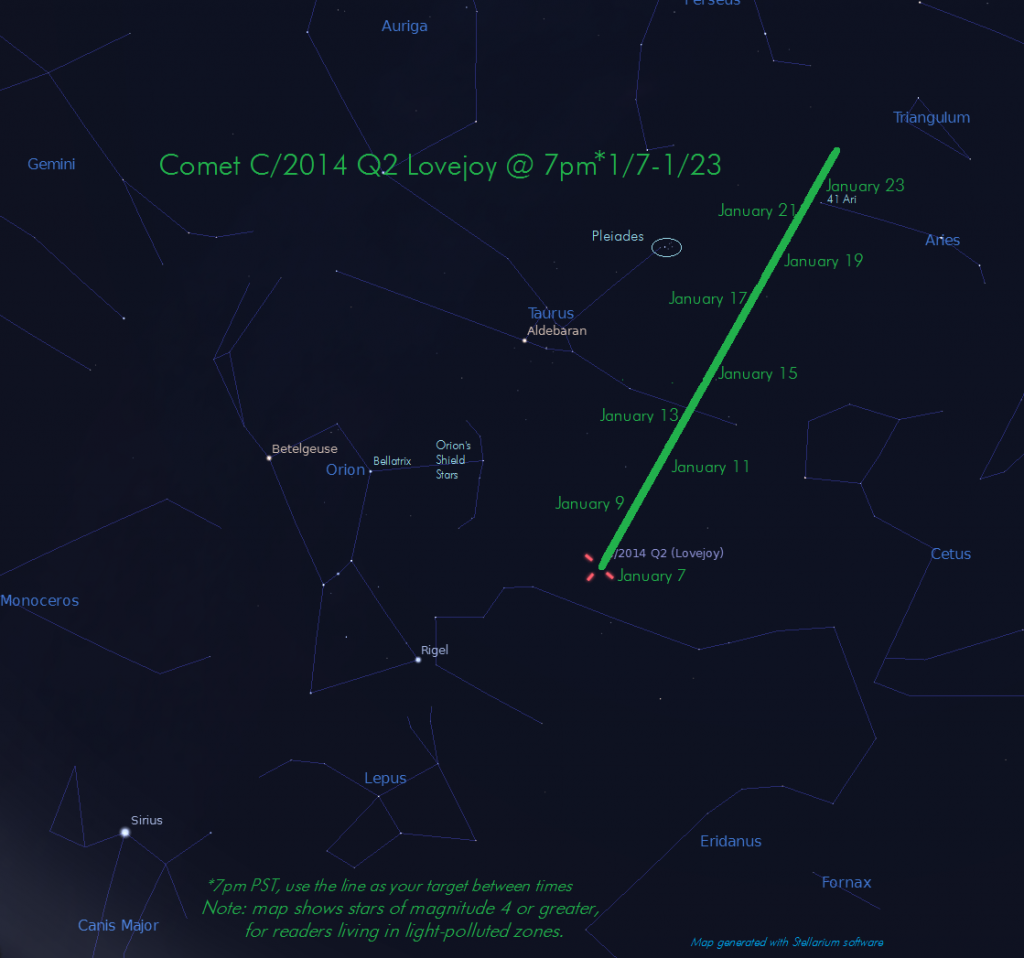
Orion is your best friend here, with its unmistakable septuplet of bright stars. The comet will be passing out of the faint winding constellation Eridanus and through Taurus over the next two weeks. On the nights of January 11-13, you can hop from Bellatrix through Orion’s shield and hit the comet easily with binoculars. The following week, it passes that bright, beautiful cluster of antiquity, the Pleiades, and on January 23, as it nears the end of its brightest moment in this passage around the sun, you can aim almost any instrument at the faint star 41 Ari and catch the glowing coma.
Capturing the Moment
If you’d like to get a snapshot of the comet from your telescope, you can do so, with practice, using your smartphone, an adapter (there are hundreds of them on eBay), and the NightCap Pro app. Check out the blog iAstrophotography for tips and tricks: you’ll be surprised just how much of the night sky you can capture these days between tweets and texts. For those of you with DSLR cameras and a tripod, the old Waiting for ISON blog has a fantastic, detailed guide for novices on imaging that is a must-read.
I hope this guide has been thorough but simple enough to use in your quest to see your first (of hopefully many) comets. A green visitor like Lovejoy, visible from nearly anywhere, is a rare and beautiful site. Clear skies to you!
